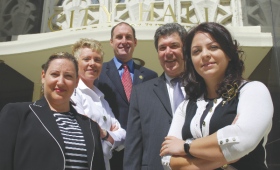The City of Burbank is taking a page from its past to prepare for its future. The back to basics approach to economic development used by the city following the departure of aerospace jobs in the 1990s has been dusted off and updated for a new century and a new economy. Whereas that previous effort focused on retail and entertainment industry jobs this time around Burbank looks long-term and ahead of the curve. Yes, the slogan “The Media Capital of the World” still gets played up but the city also casts an eye toward green technology and sustainability. At the center of this effort is an economic development team mixing various levels of expertise in city government: the high energy of Deputy City Manager Joy Forbes and Economic Development Manager Mary Hamzoian with the long experience of Greg Hermann, the interim community development director and Ruth Davidson-Guerra, head of the redevelopment department. Rounding out the group is City Manager Mike Flad, a Burbank native who worked his way up through the city government to earn the top administrative position in early 2009. This is not business as usual at City Hall but instead a culture in which innovation and risks are encouraged. If some of the ideas don’t pan out then that’s okay too. “If we are doing this and not failing with some of (the ideas) we are not pushing hard enough,” Flad said. A city of 100,000, Burbank casts itself as a small town in an otherwise overwhelming urban area. It draws in businesses by having no gross receipt tax, accessibility to the elected officials and city staff, and top notch city services. While the city has never had a problem attracting major employers – it won out against Los Angeles when Yahoo! Search Marketing was relocating from Pasadena in 2006 – when the economy began to go soft that was seen as an opportunity rather than a hurdle. By taking those opportunities now, city staffers said, both the city and business can benefit. “It is more expansive kind of thinking process beyond just wait for developers to come and purchase parcels and do development,” said Burbank Chamber of Commerce President Gary Olson. Accessibility praised To Jeff Worthe, of M. David Paul and Associates, the largest developer of office space in the city, it’s not so much a new tactic by the city than just stepping up what it has done all along. “The most important thing the do is they are willing to be available,” Worthe said “In other cities how often is the city manager or the mayor accessible to a company.” As a start, Flad and his team have identified industry clusters they want to work with. Entertainment and media is a given but others include medical and manufacturing. One cluster that Flad identified as one the city was weak in is hospitality and tourism. On the table is creating a tourism business improvement district in which the city’s hotels would tack on a fee to room rates that would then go toward marketing and advertising the city. Business improvement districts have proved successful in downtown, Burbank Boulevard and in the Magnolia Park neighborhood. Tom Whelan, general manager at the Hotel Amarano, agreed that the city could do a better job promoting itself as a destination. “When people think of L.A. they think of Hollywood or Santa Monica but how many think of Burbank?” Whelan said. “A lot of people come here. If someone wants to go to Jay Leno or “Ellen” they come to Burbank.” Marketing campaign As the tourism business improvement district gets discussed, the city is embarking on a new marketing campaign that includes ads in the “Where” guestbook made available in 20,000 hotel rooms; the new yumyumburbank.com website to promote the city’s restaurants; and an ad campaign extolling to the virtues of Burbank as a great place to live. In the planning stages is a project with Woodbury University to create a special innovation zone along south San Fernando Boulevard that would include an incubator for green tech companies. The city is not actively searching out companies to locate there but has talked with several solar panel companies. Taken together with a city-sponsored Ethernet program that will make available to businesses high-speed broadband connections, the innovation zone may meet or beat expectations. The chamber’s Olson predicts the zone could serve as a template for the rest of the city in master planning. “We hope to create new jobs, green jobs and sustainable development,” Davidson-Guerra said.
